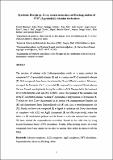Por favor, use este identificador para citar o enlazar a este item:
http://hdl.handle.net/10261/232840COMPARTIR / EXPORTAR:
 SHARE
BASE SHARE
BASE
|
|
| Visualizar otros formatos: MARC | Dublin Core | RDF | ORE | MODS | METS | DIDL | DATACITE | |

| Título: | Synthesis, reactivity, X-ray characterization and docking studies of N7/N9-(2-pyrimidyl)-adenine derivatives |
Autor: | Martínez, Daniel; Pérez, Adriá; Cañellas, Santiago; Silió, Ivan; Lancho, Aida; García Raso, Ángel; Fiol, Joan J.; Terrón, Ángel; Barceló Oliver, Miquel; Ortega Castro, Joaquín; Molins, Elies CSIC ORCID ; Frontera, Antonio | Palabras clave: | Adenine complexes Ir(III) complexes Ag(I) complexes DFT calculations Supramolecular chemistry Docking studies |
Fecha de publicación: | feb-2020 | Editor: | Elsevier | Citación: | Journal of Inorganic Biochemistry 203: 110879 (2020) | Resumen: | The reaction of adenine with 2-chloropyrimidine yields as a major product the unexpected N7-(2-pyrimidyl)-adenine (1) and as a minor one N9-(2-pyrimidyl)-adenine (2). Both compounds have been characterized by X-ray diffraction analysis. Moreover, we report the formation of a 1:1 co-crystal (3) composed by compound (1) and adenine that was formed serendipitously during the synthesis of (1). Unexpectedly, the treatment of (1) with Brönsted acids like HCl or HNO3 causes the opening of the imidazole ring of the N7-substituted adenine, yielding N5-(pyrimidin-2-yl)pyrimidine-4,5,6-triamine (4–7) which we have X-ray characterized in its neutral, (4), monoprotonated [nitrate salt (6)] and diprotonated forms [hydrochloride salt (5) and, also, a tetrachlorozincate salt (7)]. Finally, we have used compound (5) as ligand to synthesize and X-ray characterize its complexes with Ir(III) and Ag(I) (compounds (8) and (9), respectively), where the latter is a 2D coordination polymer and the former is a discrete mononuclear complex. We have studied the supramolecular assemblies formed in the solid state by using density functional theory (DFT) calculations. Finally, DNA-docking studies of several compounds have been carried out in order to analyze their ability to interact with the DNA. | Versión del editor: | http://dx.doi.org/10.1016/j.jinorgbio.2019.110879 | URI: | http://hdl.handle.net/10261/232840 | ISSN: | 0162-0134 |
| Aparece en las colecciones: | (ICMAB) Artículos |
Ficheros en este ítem:
| Fichero | Descripción | Tamaño | Formato | |
|---|---|---|---|---|
| Martinez_JInorgBioch_2020_postprint.pdf | 8,28 MB | Adobe PDF |  Visualizar/Abrir |
CORE Recommender
NOTA: Los ítems de Digital.CSIC están protegidos por copyright, con todos los derechos reservados, a menos que se indique lo contrario.
